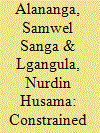|
|
|
Sort Order |
|
|
|
Items / Page
|
|
|
|
|
|
|
| Srl | Item |
| 1 |
ID:
186435


|
|
|
|
|
| Summary/Abstract |
Despite of the promising benefits of modern and clean cooking energies, its adoption has been extraordinarily low in Tanzania principally owing to preferences for Dirty and Clean Energy Mixes (DCEMs) over Clean Energy Mixes (CEMs). This study examines this energy stacking behavior based on a 2018 survey dataset of 245 useable responses from Kigamboni district in Dar es Salaam Tanzania. It is notable that the energy transition is from Single Dirty Energy (SDE) or Dirty Energy Mixes (DEMs) towards CEMs via Single Clean Energy (SCE) i.e. LPG with DCEMs in both its lower and upper sides. This approach tends to lengthen the path of transition because CEMs for cooking purposes is only affordable to the minority very high SES class. As a result the majority poor are pushed into the dirty energy “trap” despite of the booming LPG market. Although LPG support initiatives can eliminate dirty non-commercial energies, such initiatives cannot solely be relied upon to reducing the domestic consumption of dirty commercial energies even at high SES. Policy options are two way; either to alleviate SES to the level that quicken the transition or adopt wider electrification alongside appliance subsidies or microfinance to enhance CEMs affordability.
|
|
|
|
|
|
|
|
|
|
|
|
|
|
|
|
| 2 |
ID:
105795


|
|
|
|
|
| Publication |
2011.
|
| Summary/Abstract |
An explorative survey was carried out on rural and semi-urban households to find out the energy consumption pattern with respect to socio-demographic and geographic factors in Bangladesh by using stratified random sampling technique. The study revealed that 100% of the households used biomass, 98% kerosene, 61% electricity, 23% LPG and 5% candle in the rural areas. In the semi-urban areas, 100% of the households used electricity, candle and natural gas, 60% kerosene and 13% petrol. Households' mean expenditure for total energy was US$ 5.34 (SE, 0.43) with total income US$ 209.84 (SE, 6.69) month-1 in the rural areas, while it was US$ 6.20 (SE, 1.35) in the semi-urban areas with the total income US$ 427.76 (SE, 24.19) month-1. This study may be a useful baseline information to energy policy makers in Bangladesh.
|
|
|
|
|
|
|
|
|
|
|
|
|
|
|
|
| 3 |
ID:
127263


|
|
Factors influencing perceptions of domestic energy information: content, source and process
/ Simcock, Neil; MacGregor, Sherilyn; Catney, Philip; Dobson, Andrew, Ormerod, Mark, Robinson, Zoe Ross, Simon Royston, Sarah Hall, Sarah Marie
|

|
|
|
|
| Publication |
2014.
|
| Summary/Abstract |
Reducing household energy consumption is an essential element of the UK Government's carbon reduction strategy. Whilst increased knowledge alone will not necessarily lead to tangible actions on the part of consumers, knowledge of various kinds is, we argue, still important if domestic energy usage is to be reduced. In an attempt to 'educate' the public, governments have typically resorted to 'mass information' campaigns that have been considered largely unsuccessful. Yet understanding what alternative forms of learning could be cultivated has been limited by the dearth of research that explores whether and why people consider information about energy and energy saving to be useful. By exploring this, we can move towards an understanding of how knowledge about energy saving can be better shared and communicated, enabling more meaningful learning to take place. Drawing on in-depth qualitative data with fifty-five participants, this paper highlights a range of factors that affect perceptions of energy information. It argues that these factors are not discrete, but are interlinked. A fundamentally different model of knowledge exchange is needed for more effective learning about energy saving to occur. A number of implications for policy are proposed in our conclusions.
|
|
|
|
|
|
|
|
|
|
|
|
|
|
|
|
|
|
|
|
|